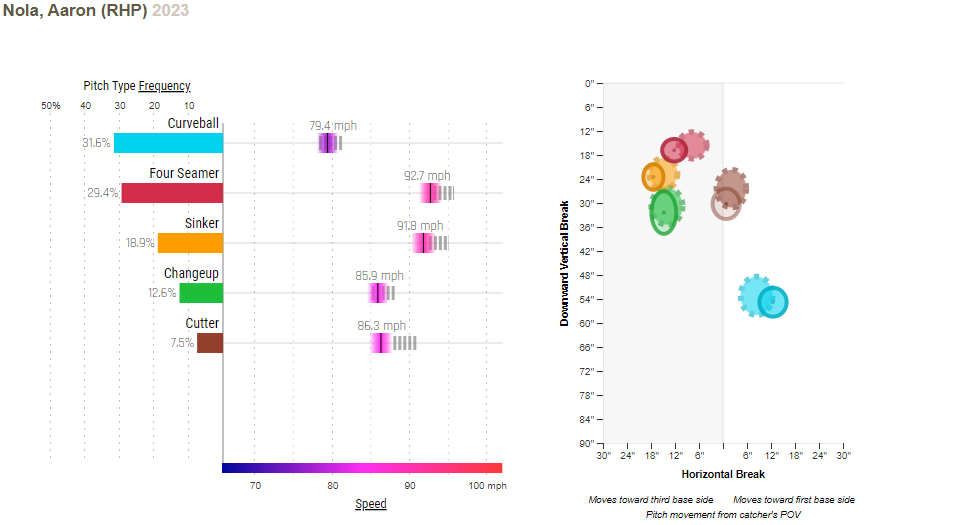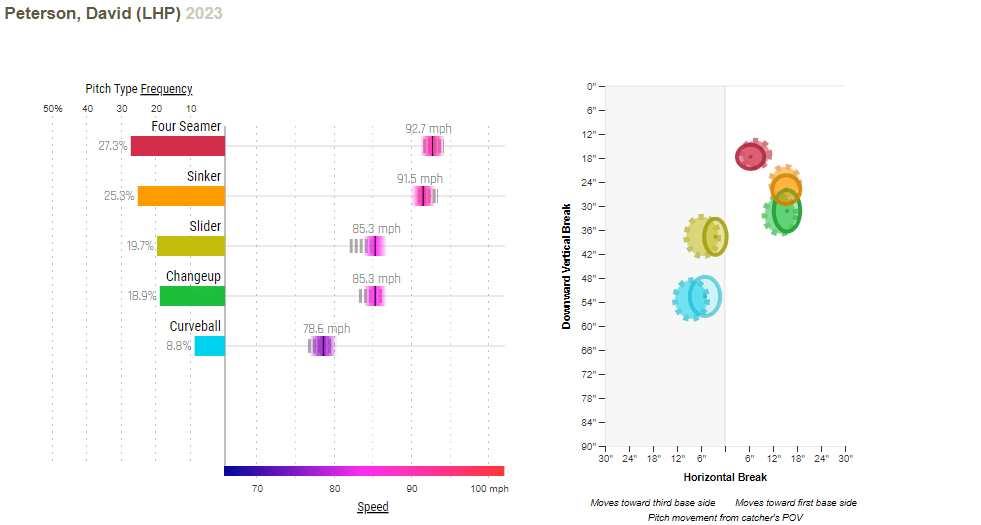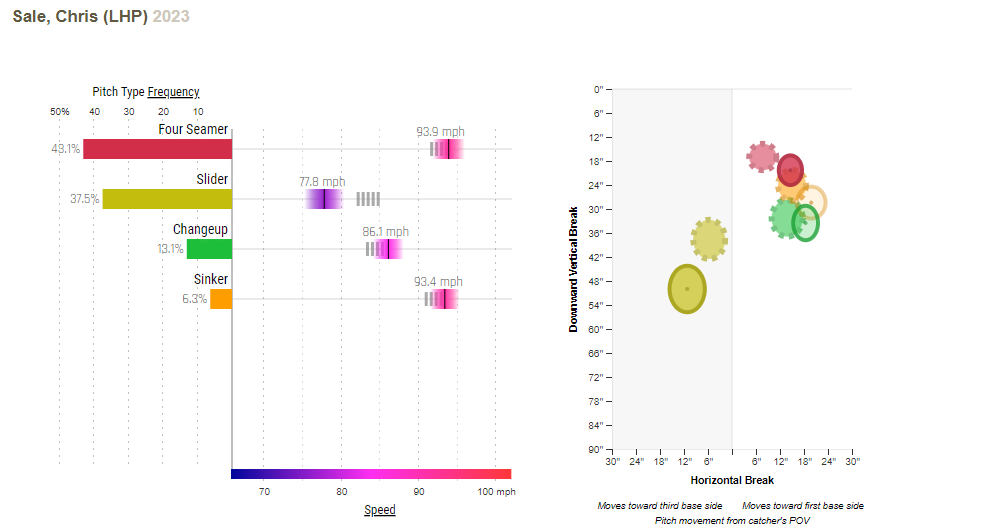The NL East was once again competitive in 2023, with three teams making the playoffs, the Nationals rebuilding their young roster, and the Mets continuing to work on building a competitive team under new owner Steve Cohen.
The five teams combined for a 104 OPS+ and a 101 ERA+, with the Nationals weighing the other four down in pitching. This solid performance came without the likes of longtime Mets superstar pitchers, including Jacob deGrom, Max Scherzer, and Justin Verlander at different points over the past few years.
Newer/young pitchers such as Kodai Senga, Jesús Luzardo, and basically the entire Atlanta rotation impressed greatly in 2023 while giving fans of teams in the NL East some more exciting pitching to look forward to in the future.
Some pitchers in the NL East, however, failed to build upon past performance in 2023. Some of these pitchers include Aaron Nola, David Peterson, and Chris Sale, although Sale did so in the AL East and moved to the NL in a December trade between the Red Sox and the Braves.
While falling a bit in performance, albeit in varying degrees, these pitchers showed signs that they can get back to their former selves in one way or another in 2024.
Aaron Nola, a workhorse in a strong Phillies rotation, had a somewhat rough 2023 season, pitching to a 4.46 ERA and 4.03 FIP after having just a 3.25 and 2.58 ERA and FIP in 2022. While these numbers weren’t bad, they were below average, and certainly under the standards Nola has set for himself through his MLB career so far.
The Phillies weren’t concerned with this downward trend, signing Nola to a 7-year, $172 million deal in November. Still, the Phillies possess the ability to trade Nola in the first few years, as a no-trade clause was not present in the contract agreements.
Nola has been consistently above average during his time with the Phillies so far.
While his 2021 season wasn’t great, with a 4.63 ERA, his FIP was still well above average at 3.37. Instead, his 2023 FIP stayed above 4.00, as he saw the highest home-runs-per-nine rates of his career and his lowest strikeouts-per-nine since his rookie season in 2015. Nola’s raised ERA/FIP can be mostly attributed to this home-run-per-nine and strikeout-per-nine regression.
Primarily, Nola has succeeded at limiting home runs by having solid exit velocities and ground ball rates, which have kept his fly balls from doing too much damage. However, in 2023, Nola’s groundball rates and exit velocities got worse, leading to a home-run-to-fly-ball rate jump from 11.0% in 2022 to 19.0% in 2023, which is very high. Typically, an abnormally high home-run-to-fly-ball rate will regress in the future, although Nola will have to improve his exit velocity numbers a bit to do so.

Data via Baseball Savant (dotted circle = league average)
Nola has always had above-average movement on his pitches; from 2020-2022, Nola’s average PLV was an elite 5.30. However, in 2023, Nola’s average PLV dropped to 5.15. While still above average, a drop off from 2022’s 5.35 is significant.
Still, Nola shouldn’t have many problems with his stuff.
His best pitch, his curveball, continued to generate excellent results as his changeup worked as another solid secondary. Nola’s four-seam and sinker, however, saw some noticeable regression in performance. While never “fast,” these pitches saw solid results due to Nola’s great command and their high horizontal movement. Both pitches were hit harder than usual and were slugged much more often, with the four-seamer in particular jumping from a .356 SLG in 2022 to a .503 in 2023. Nola’s cutter struggled somewhat as well, although it still got solid whiff rates and serves as a decent fifth pitch.
Overall, Nola saw some regression in performance, leading to many more home runs and fewer strikeouts. However, I don’t believe this regression will be completely sustained either.
Nola recognized his four-seamer’s poor performance, leading to his highest curveball usage since 2019 and lowest four-seamer usage since 2020. In 2024, expect Nola to continue adapting his arsenal to stay on top of his fastball performance while maximizing the efficiency of his elite curveball.
David Peterson had a rough season in 2023, pitching to a 5.03 ERA and 4.34 FIP over 111.0 innings, often filling in for the repeatedly injured Mets rotation.
In November 2023, Peterson had surgery on his hip, resulting in a timeline to rejoin the Mets in early-to-mid May 2024. However, I still believe Peterson can make an impact for the Mets down the stretch of the season.
Peterson has had the least success in the majors among the three pitchers in this article. His best season was in 2022, where he posted a 3.83 ERA and 3.64 FIP in 105.2 innings.
Coming into the majors, Peterson impressed in a small sample during the 2020 COVID-shortened season, despite never truly building himself as an elite pitching prospect. Instead, Peterson succeeded through a rare mix of high ground-ball and strikeout rates. While Peterson’s hard-hit rates have consistently been below average, his ground ball and whiff rates have allowed this damage to be somewhat limited. In 2023, while ground ball rates went up, his strikeouts dropped, resulting in his effectiveness falling as well.
Primarily, Peterson’s drop in performance stemmed from his pitch qualities.

Data via Baseball Savant (dotted circle = league average)
Peterson relies on five pitches fairly consistently, with none generating excellent movement. His slider generated great results in 2022, with a 47.9% whiff rate and a .292 SLG, setting it up to round out Peterson’s arsenal as his go-to put-away pitch. Instead, in 2023, his slider’s results were not great, with a solid 39.4% whiff rate but poor .472 SLG.
Peterson’s four-seam and sinker were never elite, but avoided being liabilities through decent velocity and consistently being located on the edges of the strike zone. However, in 2023, Peterson lost a tick on both his four-seam and sinker, resulting in fewer chases above the zone and more damage when located inside the zone. Peterson’s lower velocity on his fastballs, as well as being in the zone even less than before, caused Peterson’s average PLV to drop from a somewhat average 4.94 in 2022 to a below-average 4.82 in 2023.
It should also be noted that Peterson’s mechanics could have played a part in his performance. Many reports indicated Peterson had mechanical issues early in the season, leading to an 8.08 ERA in his first eight starts, with Peterson returning to solid form in the second half of the season.
Entering 2024, Peterson isn’t a name that will get many people excited. Still, Peterson has the ability to perform well, and with the Mets building toward 2025, Peterson can play a key role in their rotation of the future. For Peterson to succeed, along with staying healthy, he should aim to rebuild some velocity, while regaining his slider’s elite performance in 2022. At only 28, Peterson can easily continue to improve, and that can definitely take place in 2024.
Chris Sale had his longest season since 2019 in 2023, pitching to a 4.30 ERA in 102.2 innings through 20 starts. While not up to the elite level he pitched to throughout his earlier seasons in the MLB, Sale stayed mostly healthy, asides from a mid-season stint on the 60-day IL due to shoulder inflammation, which is most important for him at this point of his career.
Entering his age-34 season, now with Atlanta, Sale can prove himself to still be the elite pitcher he once was with a solid 2024 season. To do so, Sale needs to not only stay healthy but pitch well too. While his 4.30 ERA in 2023 wasn’t too bad, it needs to improve for Sale to truly make an impact in a talented Braves rotation.
Sale’s strikeout, walk, and home run rates were fairly normal in 2023, as his FIP stayed below his ERA at 3.80, just like it would in his prime. Because of this, Sale’s redemption primarily lies in the stuff his pitches possess.

Data via Baseball Savant (dotted circle = league average)
Sale has always had a unique pitch arsenal, with his four-seamer and slider generating the best results. In addition, Sale’s pitch shape is incredibly unique; all of his pitches have elite horizontal movement, which allows them to generate such high whiff rates, and thus, high strikeout rates.
In 2023, while retaining this movement, Sale didn’t return to the pitch velocities of the past. In 2019, his last full season, his velocities were similar to 2023, and his performance was not great. The year before, his four-seamer averaged over 95 mph, resulting in an elite 2.11 ERA and 1.98 FIP.
While it might be difficult to build back up a few ticks at 34, Sale’s outlier success has often correlated with higher velo on his fastball. By restoring this, Sale is taking a big step towards getting back to his former self.
In 2018, Sale’s slider also averaged 79.7 mph, which is down to 77.8 mph in 2023. While velocity is not as important for sliders, it resulted in a drop in whiff rate, while batters increased their HardHit rate from 20.5% to 32.0% on the pitch.
Velocity seems imperative for Sale to restore his success of the past.
Thankfully, Sale has shown flashes of this restored velocity so far in spring training, sitting 95 mph and topping out at 97 mph in his first start of the year. Spring training is not always indicative of in-season performance, but Sale showing he can get back to these velocities after entering spring training healthy is excellent news.
For Sale’s future, his number one priority will always be staying healthy. At 34, health will continue becoming a greater risk, but an offseason of preparation, along with 20 starts for the Red Sox in 2023, may have positioned Sale for a healthy 2024 season and beyond.
